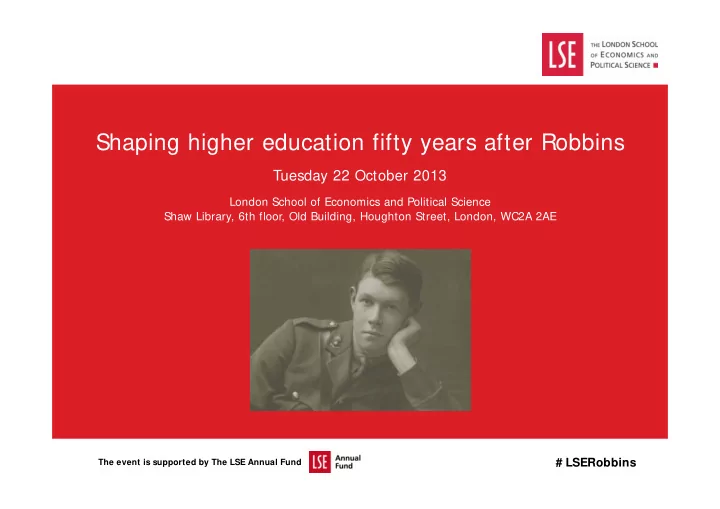

Shaping higher education fifty years after Robbins Tuesday 22 October 2013 London School of Economics and Political Science Shaw Library, 6th floor, Old Building, Houghton Street, London, WC2A 2AE # LSERobbins The event is supported by The LSE Annual Fund
What happened later: the British road to mass HE David Watson Principal, Green Templeton College Conference on “shaping higher education fifty years after Robbins” London School of Economics 22 October 2013
Outline • Dimensions of mass higher education • Legislative hyper-activity • Fees and funding • Institutional diversity • Facing the future
Mass HE In theory (Martin Trow): • Below 15% - elite • 15-40% - mass • 40% (later 50%) + - universal. In practice (BIS 2012): • GB - 49% • Scotland – 55% • Men – 45% • Women – 55%
Total higher education student numbers, UK, 1960/61 – 2010/11 White 2200000 Paper Dearing (2003) (1997) 2000000 1800000 1600000 1400000 1200000 Robbins 1000000 (1963) 800000 600000 400000 200000 0 1960/1 1965/6 1970/1 1975/6 1980/1 1985/6 1990/1 1995/6 2001/02 2005/6 2010/1 5 Source: DES 1969; HESA 1999, 2002; HEPI 2003
Number of HE students by mode of study and level of course, 1979-2011 Source: DES 1991-1992; DfE 1994; HESA 1996-2013
UK unit public funding, 1979-2003 INDEX Year University HEFCE Polytechnic 1979/80 100 100 1980/81 106 99 1981/82 103 94 1982/83 106 89 1983/84 107 82 1984/85 106 79 1985/86 103 78 1986/87 102 79 1987/88 105 76 1988/89 103 75 1989/90 100 100 ‐ 1990/91 91 1991/92 86 1992/93 80 1993/94 75 1994/95 73 1995/96 70 1996/97 65 1997/98 64 1998/99 63 1999/2000 63 2000/01 62 2001/02 63 2002/03 63
UK Government HE initiatives since 1963: twelve “ frameworks 1963: the Robbins report – creation of “ new ” universities, “ ability to benefit. ” 1. 2. 1965: the Woolwich speech – creation of the Polytechnics 1972: the James report – reorganisation of teacher training, “ diversification. ” 3. 1980-85: the Tory cuts – withdrawal of “ overseas ” subsidy, White Paper on contraction 4. and rationalisation 1985: the National Advisory Body for Public Sector HE (NAB), “ capping the pool, ” 5. centralisation of local authority HE 6. 1988: the Great Education Reform Act – incorporation of the Polytechnics, Central Institutions and large Colleges 7. 1992: Further & Higher Education Act – ending of the binary line, Funding Councils for devolved administrations, creation of the “ new new ” universities 8. 1997: the Dearing Report – fees for FT undergraduate students 2004: Higher Education Act – variable fees, “ new new new ” universities, foundation 9. degree awarding powers for FECs 10. 2009: Higher Ambitions – New Labour’s parting shot 11. 2010: the Browne Review – higher undergraduate fees, new student contribution system 12. 2011: Students at the Heart of the System
UK HE policy: “mood swings” • Con 1 (1979-1985) – contraction and differentiation • Con 2 (1985-97) – expansion and equality • New Labour 1 (1997-2004) – expansion and equality • New Labour 2 (2004-2010) – return to two tiers, co- payment • The Coalition (2010 - ) - contraction and radical co- payment
UK “types” of university (after Scott, 1995) 1. Oxford and Cambridge 8. Specialised/monotechnic 2. University of London 9. Old new (1960s) 3. Victorian/Edwardian Civics 10.New new (1992) 4. Redbricks 11.New new new (2004) 5. Isolates: e.g. Durham and 12.Mixed economy (HE in FE) Keele 13.Private: Buckingham 6. Technological (ex CAT) 14.For profit 7. Open University
The modern university: key types 1. The international research university 2. The professional formation university 3. The ‘curriculum innovation” university 4. The distance/open learning university 5. The College 6. The specialised/single subject HEI 7. The “for profit” corporation
Enrolments of international (non-EU) domiciled students, 2008/09 8000 7000 6000 Sector 5000 Russell 1994 4000 Million+ GuildHE 3000 Alliance 2000 1000 0
Income from international (non-EU) student fees as a percentage of total income, 2008/09
Percentage of UK-domiciled first year students from minority ethnic groups, 2008/09 80% 70% 60% 50% Sector Russell 1994 40% Million+ GuildHE Alliance 30% 20% 10% 0%
Percentage of young full-time first degree entrants from national statistics socio-economic classification classes 4, 5, 6 and 7, 2008/09 70 60 50 Sector Russell 40 1994 Million+ 30 GuildHE Alliance 20 10 0
Percentage of first- and upper second-class degrees awarded, 2008/09, by interest groups 100% 90% 80% 70% Sector Russell 60% 1994 50% Million+ 40% GuildHE Alliance 30% 20% 10% 0%
Funding of research through the dual support system as a percentage of total income, 2008/09, by interest groups 35% 30% 25% Sector Russell 20% 1994 Million+ 15% GuildHE Alliance 10% 5% 0%
Research grants and contracts as a percentage of funding council research grants, 2008/09 3000% 2500% 2000% Sector Russell 1994 1500% Million+ GuildHE Alliance 1000% 500% 0%
Days ratio of net liquidity to total expenditure, 2008/09 350 300 250 Sector 200 Russell 1994 150 Million+ GuildHE 100 Alliance 50 0 -50
Surplus/deficit as a percentage of income, 2008/09 25 Sector Russell 20 1994 15 Million+ GuildHE 10 All iance 5 0 -5 -10 -15 -20
Percentage ratio of total long-term borrowings to total income, 2008/09 250 200 Sector 150 Russell 1994 Million+ GuildHE 100 Alliance 50 0
The security index, 2008/09, by interest groups
Stage 1: Complex Transitions Source: Furlong 2008
Discussion
Shaping higher education fifty years after Robbins Tuesday 22 October 2013 London School of Economics and Political Science Shaw Library, 6th floor, Old Building, Houghton Street, London, WC2A 2AE # LSERobbins The event is supported by The LSE Annual Fund
Recommend
More recommend